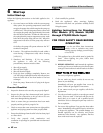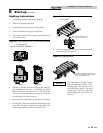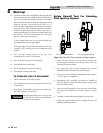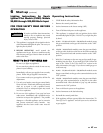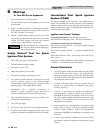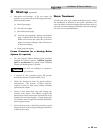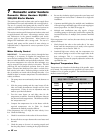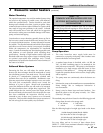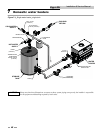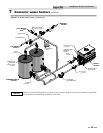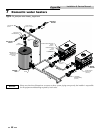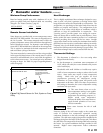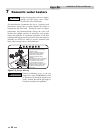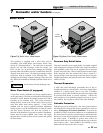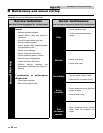
7 Domestic water heaters (continued)
47
Installation & Service Manual
Water Chemistry
The required temperature rise and the standard pump sizing
are based on the heating of potable water with chemistry
within the specified limits. Caution should be used when
heating water softened to less than 5 grains per gallon. Many
commercial water softeners reduce hardness to 0 grains which
may result in long term problems in the system. Softened
water will usually have a lower pH which can be aggressive
and corrosive causing non-warrantable damage to the heater,
pump, and associated piping.
Corrosion due to water chemistry generally shows up first in
the hot water system because heated water increases the rate
of corrosive chemical reactions. As water is heated it becomes
less soluble. The dissolved minerals and solids will precipitate
and collect as scale if water velocity is not properly controlled.
Follow the temperature rise requirements for unsoftened
water. Consult the manufacturer when heating potable water
with hardness or total dissolved solids exceeding these
specifications. Heating of high hardness and/or high total
dissolved solids water may require a larger circulating pump,
an optional cupro-nickel heat exchanger and a revised
temperature rise specification based on the water chemistry of
the water to be heated.
Softened Water Systems
Decreasing the flow rate will reduce the erosion process,
however the heat exchanger should be monitored to ensure
the scale/liming process is not made worse. The unit should
be placed on a comprehensive inspection schedule until
optimum flow rates can be established. Problematic water
areas may require heat exchanger inspection every two weeks.
The total scale accumulation should never exceed the
thickness of a piece of paper. Should scale accumulation
exceed this thickness the flow rate will need to be increased.
The tubes should not have a bright shiny copper look. This
would indicate that the erosion process has begun and the
flow rate will need to be decreased. Once the proper flow rates
have been established the inspection intervals can be
increased to every 30 days, once a quarter, or to a bi-annual
inspection. This procedure should ensure proper operation of
the unit as long as the water quality stays consistent.
TABLE - 7B
COMMON WATER MANIFOLD SIZE FOR
MULTIPLE HOT WATER SUPPLY BOILER
INSTALLATIONS
Pipe sizing chart provides minimum pipe size for common
manifold piping and tank tappings to ensure adequate flow.
Number of Units Common Manifold Size (Min.)
1 2"
2 2"
3 2 1/2"
4 3"
5 3 1/2"
6 3 1/2"
Pump Operation
1. The water heater/hot water supply boiler must be
connected to a properly sized pump that circulates water
between the heater and storage tank.
2. A standard water heater is furnished with a 1/6 HP, 120
VAC, 3.6 AMP circulating pump to be mounted on the
units in let water connection. This pump is sized based on
installation of a single storage tank and heat er in close
proximity. If the number of fit tings and straight pipe
exceeds the quantities shown in this sec tion, a larger pump
will be required.
3. The pump must run continuously when the burners are
firing.
4. Lubricate the pump to the manufacturers rec om men da tions.
Pump damage due to inadequate lu bri ca tion is
non-warrantable.
5. Pump is sized to heater input and water hard ness. Care
should be taken to size the pump correctly. See “Water
Chemistry”, this page.
The standard pump selection is based on the fol low ing pipe and
fittings from the unit to the stor age tank:
6 - 90° elbows 2 - ball valves
2 - unions 1 - cold water tee
Plus the following length of straight pipe based on the heater
size:
90,000 through 360,000 Btu/hr Models
Not more than 45 feet of straight pipe
399,999 through 500,000 Btu/hr Models
Not more than 25 feet of straight pipe
For every elbow and tee in excess of those shown above,
DEDUCT 5 FEET from maximum allowable straight pipe in
heater to tank circulating loop.




